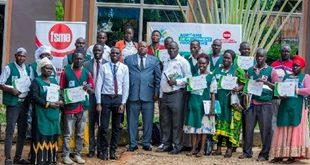
By Obiageli Katryn Ezekwesili
Less than a year ago, there was a sense of optimism in many African countries. Growth rates in Sub-Saharan Africa were comparable to Asia, hovering around 6 percent, a result of high commodity prices, a favorable global environment — and also of improved economic management, investment climate, private flows and governance.
But an unprecedented global crisis now threatens these gains, as most countries in Africa are beginning to feel the full brunt of the recession.
Growth in the region is projected to plummet to 2.4 percent in 2009, resulting in increased poverty and infant mortality and in rapidly deteriorating budget situations.
This is particularly the case for commodity-rich countries which had benefited from the rapid increase in revenues over the preceding years. Those revenues had led to growth in many African countries. But as a result of the financial crisis, the drop in diamond prices in Botswana has caused the major operator of diamond mines to suspend operations. In Zambia, where the price of copper had almost doubled over the last three years, reaching US$9000 in 2008, prices have now fallen to less than US$4000 in the past few months.
Copper mines in the Democratic Republic of Congo have been similarly affected, as have oil prices in Gabon. The current crisis translates into budget strains, a slowdown in foreign investment, an increase in unemployment, and deterioration of human development indicators.
In times of high commodity prices, good management of oil and mining revenues had the potential to be a springboard for development. With a far less hospitable global environment, it becomes even more urgent for governments to make judicious use of their available resources, and to take the structural and institutional measures that will ensure that future booms “ which will undoubtedly occur again “ are harnessed to fight poverty and improve the lives of citizens.
How can governments make sure that resource revenues are well used?
Some 28 African governments have adopted the Extractive Industries Transparency Initiative (EITI), with the aim of improving governance through the verification and full publication of company payments and government revenues from oil, gas and mining. In addition, 37 oil, gas and mining companies have agreed to support the initiative, as have institutional investors managing assets amounting, before the financial crisis, to more than $14 trillion.
Joining the EITI is a first step, and one that sends a strong signal of government’s commitment to transparency. Going further, if citizens are to reap the benefits from mining revenues, transparency is needed throughout the entire resource stream, from how contracts are awarded and monitored, to how taxes and royalties are collected, to how investment choices are made and executed. This is referred to as the ‘EITI ++’ approach, which focuses on the better management of the entire resource chain that links commodity revenues to results for citizens. The international community, including the World Bank, can support countries in improving management of the commodity resource stream, and civil society will have a key role in this endeavor.
Several countries are now focusing on that resource chain. Niger and Liberia have approached their partners for technical legal assistance on awarding contracts. In Mozambique and Tanzania, analytical work is helping to foster a dialogue on public expenditure management and financial accountability in the context of rising revenues from mineral extraction. Some countries request support in such areas as auctioning of licenses and contract negotiations with major investors, management of volatile commodity-related revenues, or in improving the composition and quality of public investments.
As the crisis illustrates, commodity rich countries also need to prepare for a time when oil and mining resources might be depleted, by diversifying their sources of growth. Diversification is not a simple task; it requires major policy shifts and significant investments of resources in institutions, human capacities, health, education and infrastructure. For example, many countries with mining resources have untapped agriculture potential.
The agriculture sector has accounted for one-third of Africa’s GDP growth over the last 15 years, and with the right kinds of support, including improved water and land management, rural roads and a better policy environment, productivity and value added could increase significantly, making the sector a much stronger contributor to economic growth and poverty reduction, mitigating risk of over-dependency on mineral resources.
Taken together, these reform and diversification efforts can add up to a transformation of national economies. They can ensure that the highest development impact is extracted at times of low commodity prices from the resources earned, and they can also lay the foundation for broad-based economic growth when the high prices return. By developing other sources of growth, countries can mitigate the impact of shocks such as the dramatic decline in commodity prices in 2008.
This time around, resource-rich African countries can chart a path decidedly different from previous boom and burst cycles that have led to the paradox of pernicious poverty in the midst of resource abundance. This moment of crisis is an opportunity for economic transformation, and challenges leaders and citizens with the ‘urgency of now.’ It can be done!
****
The writer is the Africa regional Vice President of The World Bank
 The Independent Uganda: You get the Truth we Pay the Price
The Independent Uganda: You get the Truth we Pay the Price


